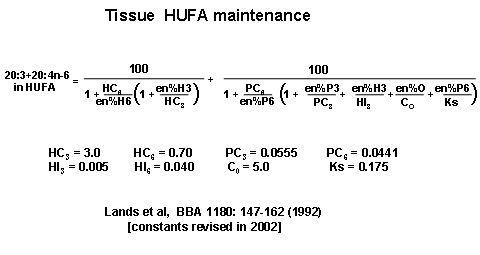Equation Relating Diets to Tissue HUFA
 An equation empirically predicts the effect of diet on the proportions of omega-6 and omega-3 eicosanoid precursors stored in the 20- and 22-carbon highly unsaturated fatty acids (HUFA). [this was reported by Lands, et al., Biochem Biophys. Acta, 1180:147-162 (1992) ]. An important aspect is the very low values for PC3 (0.055en%) and PC6 (0.044en%), indicating very efficient accumulation of HUFA from dietary PUFA.
An equation empirically predicts the effect of diet on the proportions of omega-6 and omega-3 eicosanoid precursors stored in the 20- and 22-carbon highly unsaturated fatty acids (HUFA). [this was reported by Lands, et al., Biochem Biophys. Acta, 1180:147-162 (1992) ]. An important aspect is the very low values for PC3 (0.055en%) and PC6 (0.044en%), indicating very efficient accumulation of HUFA from dietary PUFA.
The equation relates metabolic competitions among four separate types of essential fatty acid in the dietary supply expressed as a percent of food energy (en%): 1. 18-carbon omega-3 PUFA (en% P3) 2. 18-carbon omega-6 PUFA (en% P6) 3. 20- and 22-carbon omega-3 HUFA (en% H3) 4. 20- and 22-carbon omega-6 HUFA (en% H6). Each of the four types of EFA contributes differently to the overall tissue balance. Analyses with hundreds of added people eating more diverse diets led to revision of three of the eight constants from 1992 to give the values shown above. Strandjord et al. confirmed in 2017 that the empirical equation and constants successfully fit diet-tissue data from nearly 4,000 people in 92 subject groups in 34 published studies from 11 different countries.
This empirical equation is used in the interactive Omega Meals food choice software to estimate the proportions of n-3 and n-6 HUFA likely to be maintained in tissues by a set of food choices with their omega 3-6 balance scores. The scores and the software are easy tools for planning RECIPE REPAIRS to have a healthier HUFA balance.
updated June, 2018
